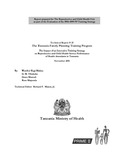| dc.identifier.citation | Kogi-Makau, W., Tibaijuka, G.M., Mtawali, G. and Rose, M. (2004) The Tanzania Family Planning Training Program:The Impact of an Innovative Training Strategy on Reproductive and Child Health Service Performance of Health Attendants in Tanzania. | en |
| dc.description.abstract | This report is based on a study, implemented in Kasulu and Kibondo districts in Kigoma Region, Tanzania, to assess the impact of a health attendants’ pilot training strategy on reproductive and child health (RCH) services. The strategy was developed and implemented by the RCH-Unit of Ministry of Health (MOH) with technical assistance from Intrah/PRIME and was implemented with financial support from USAID. The training strategy, covering a period of four months (July to October, 1998), used a combination of on-the-job-training (OJT) and traditional central and distance-based learning (DBL). The training was divided into four modules. Modules 1 and 3 were centrally based while Modules 2 and 4 used OJT and DBL in which the HAs remained at the facilities where they worked. The DBL was backed by supportive supervision from facility in-change staff as onsite supervisors, district-based supervisors and trainers and regional trainers. It also utilized two key leaning aids (developed as part of this strategy): a handbook and solar-powered cassette player with audiotapes. Each trainee was given a solar/battery-powered cassette player and six audiotapes containing course content. The study utilized three different intervention designs to assess three different levels of impact. The study used pre-and post-test assessments of knowledge and skills to determine whether learning occurred among trainees as a result of the training. A non-equivalent control group design was used to compare whether the training significantly influenced provision of reproductive and child health services in trainee facilities over facilities whether providers had not been trained. The study requested feedback from various players on the HA training strategy. This assessment addressed attributes such as appropriateness, acceptance, achievement of the project’s objectives, how the project was comprehended/perceived and the reliability of this training approach. The HA training led to acquisition of knowledge as indicated by a significant change in the mean score of Module 1 pre-test (32.8) compared to post-test mean score (71.4)(P<.05). A similar trend was found in module 3 in which the mean pre-test score (70.5) was significantly lower than the post-test mean score (87.1)(P<.05). The skills assessment demonstrated a substantial gain in two skills: antenatal clinic client assessment and conducting growth monitoring. However, counseling services, care for mothers and neonates during the postpartum period and care during and monitoring progress in labor did not improve. As a result, the investigators conducted that HAs gained adequate skills in some areas while continued learning is essential in others, possibly through further OJT by the RCH trained CO/ACO at the HA work site. Comparison sites are also in need of improved training to improve their RH/FP skills. The data collection period for the service statistics assessment was divided into three blocks: prior to training (March-June 1998), during training (July-October 1998). The intervention group comprised 29 health facilities while the comparison group contained 25 facilities. For the comparison group, data were collected only for the periods before and after training. Six study instruments (five questionnaire and one data collection sheet) were used as data collection tools. From the RCH-Unit through the regional, district and facility levels, the training approach was considered to be suitable, especially for the targeted (HA) cadre. It was agreed that this target group required a training approach that emphasized practice oriented learning methods instead of a traditional didactic approach. To meet these needs, the project provided two key learning aids: the handbook and cassette tapes. The handbook was considered to be appropriate for three reasons: the handbook satisfactorily covered the training content, it was well illustrated, and it utilized language appropriate to the target audience. The cassette tapes were considered to be suitable learning aids because they were audible and contained appropriate and adequate content. However, audibility reportedly decreased sharply as battery power diminished. Nevertheless, feedback also highlighted area for improvement. Respondents pointed out that the approach was expensive. District planning boards that are responsible for financing training in the post health sector reform (HSR) era may not be able to afford to replicate the training. As a result, they may revert to the traditional central training approach. Respondents also reported that the use of solar powered cassette players were found to be vulnerable to frequent breakdown and other minor mishaps, As a result of these failings, a recommendation was made that ordinary battery-powered cassette players be adopted for future training. A recommendation was also made to review and edit the handbook was easy to understand and the illustrations were clear, they reported that there was room for improvement in these areas as well. The sustainability of this training strategy depends on the availability of sufficient funding to carry out all of the project’s elements, especially learning at the work site. The feasibility of replicating this successful intervention remains to be demonstrated.The HA training strategy set out to achieve certain objectives: develop a curriculum and two complimentary learning aids; select and prepare trainers, and both on and offsite supervisors; update facility in charge staff on RCH; and train a selected number of HAs. It was also planned as a pilot study for testing all of the components and documenting the strengths and weaknesses of the approach. In addition, the training was geared at empowered both the DHMT members and staff at the intervention facilities. This evaluation conducted that the HA training strategy achieved these objective. | en |

